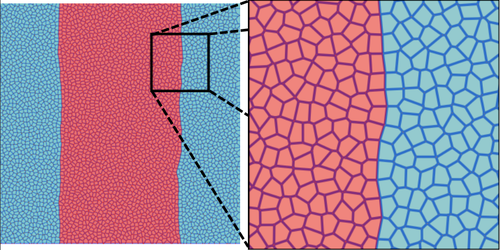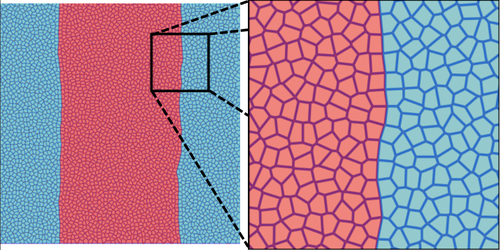Soft Tissues with Sharp Boundaries
Cells in a developing embryo tend to segregate by cell type, forming tissues with distinct boundaries. Explanations of this behavior often rely on an analogy to immiscible fluids, like oil and water, which naturally separate because of intermolecular forces. However, cells are not passive like molecules; they actively respond to their environment, or “neighbors.” New simulations explore neighbor-specific interactions that may explain the sharp tissue boundaries that characterize embryo development and some forms of tumor growth.
A common model system for investigating cellular arrangements is a two-dimensional layer of cells in which the cells fill the space by pushing into each other. From above, the cells resemble a patchwork of straight-sided polygons whose shapes depend on cell stiffness and other cellular forces. This so-called vertex model has successively reproduced biological processes such as embryonic development and tumor metastasis.
Daniel Sussman and colleagues from Syracuse University in New York explored a vertex model with two types of cells. Specifically, they simulated a tissue of A cells surrounded by a population of B cells. The team assumed that the interfacial tension along the border between A and B cells is different from that between cells of the same type. This neighbor-specific interaction created an unexpected discrepancy between two types of simulated “measurements” of the surface tension at the tissue boundary. The team obtained a lower tension value for measurements made by virtually squeezing the tissue between two plates than for measurements made by recording small-scale fluctuations, or roughness, along the tissue boundary. According to the researchers, this result suggests that while tissues and other biological systems may be soft and squishy overall, they have sharp, seemingly hard, boundaries.
This research is published in Physical Review Letters.
–Michael Schirber
Michael Schirber is a Corresponding Editor for Physics based in Lyon, France.





